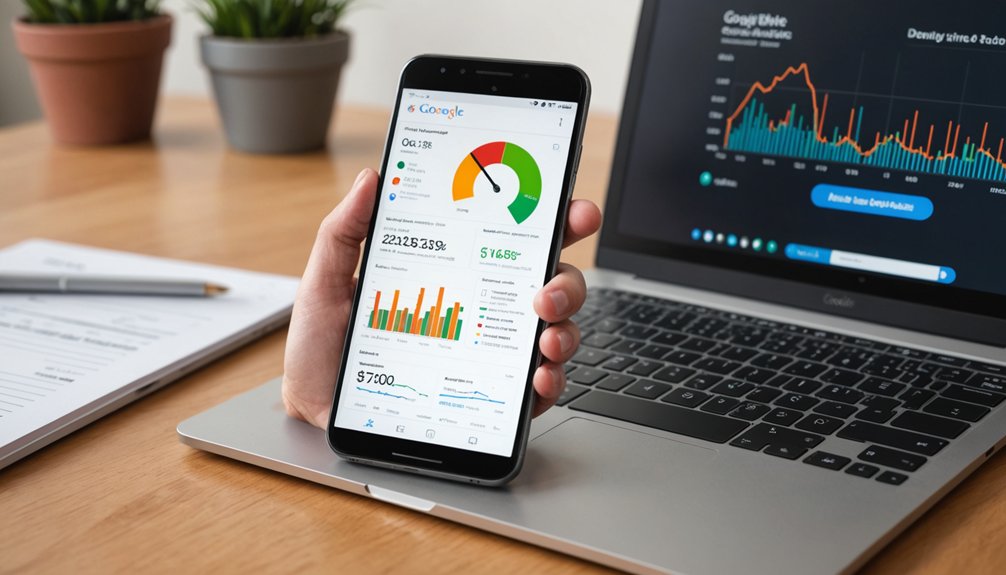Mobile-first indexing in 2025 demands responsive design with consistent HTML across devices. No more pop-ups—Google hates them. Short paragraphs, bullet points, and clear subheadings keep mobile users happy. Page speed matters; slow sites lose visitors fast. Text must be readable without zooming, and navigation shouldn’t hog screen space. Regular testing with PageSpeed Insights isn’t optional anymore. The companies that nail these practices will dominate search rankings while others wonder what happened.

Every website owner needs to face the music—mobile-first indexing is here to stay. Google has made its position crystal clear: the mobile version of your website determines your rankings. Period. The search giant’s smartphone agent crawls your site, judges your content, and decides whether you’re worthy of that coveted first-page position.
And guess what? This applies to every single website out there, regardless of when it was built.
The data doesn’t lie. Mobile users want content they can consume without squinting or endless scrolling. Short paragraphs. Bullet points. Clear subheadings. These aren’t just suggestions—they’re survival tactics in the mobile-first world. Important information buried beneath fluff? Kiss your conversions goodbye.
Mobile content demands clarity. Bury important details under fluff and watch your conversions vanish.
And those annoying pop-ups that take over the entire screen? Yeah, Google hates those as much as users do. These intrusive elements significantly impact your site rankings and traffic, hurting both user experience and search visibility. Regular meta tag audits help ensure your mobile content is properly optimized for search engines.
Responsive design remains Google’s golden child for implementing mobile-first best practices. It’s elegant in its simplicity—same HTML code, different display based on screen size. One codebase to rule them all. No separate URLs to manage, no complex redirects to mess up. Just consistent content that works everywhere. Much like quantum computing advances, the future of web development demands adaptable, efficient solutions.
Shocking concept, right?
Some businesses still cling to dynamic serving or separate URLs like it’s 2010. Sure, these approaches work—if you enjoy unnecessary complexity and constant maintenance headaches.
Dynamic serving uses the same URL but different HTML based on user-agent detection. Separate URLs create device-specific versions with their own links. Both require HTTP header gymnastics and meticulous SEO optimization. Fun times.
The clock is ticking on mobile optimization. Page speed isn’t negotiable anymore. Slow-loading images? Fixed navigation that eats half the screen? Text that requires pinch-zooming? All roads to digital irrelevance.
Mobile users are impatient. They’ll bounce faster than you can say “desktop version.”
The mobile-first reality isn’t changing. Adapt or disappear from search results. It’s really that simple.
Regular testing with tools like Google’s PageSpeed Insights is essential to identify and fix performance bottlenecks that could be dragging down your mobile rankings.
Frequently Asked Questions
Will Google Penalize Desktop-Only Websites in 2025?
Google’s likely to come down hard on desktop-only sites in 2025.
All signs point to yes. The search giant’s been pushing mobile-first indexing for years now, and the screws are tightening.
Sites without mobile optimization face traffic drops, reduced visibility, and the dreaded “user-unfriendly” label.
With most web traffic coming from phones these days, sticking to desktop-only is basically digital suicide.
Google’s message? Adapt or disappear from search results.
Pretty simple math.
How Often Does Google Crawl Mobile Sites Compared to Desktop?
Google now crawls mobile sites more frequently than desktop versions.
Since adopting Mobile-First Indexing, Googlebot Smartphone has become the primary crawler. Desktop-only sites? They’re getting the cold shoulder.
Come July 5, 2024, Google will completely stop crawling non-mobile-compatible sites. Brutal, but that’s the reality.
Sites with fresh content get crawled more often regardless of platform. But make no mistake—mobile optimization is no longer optional. It’s the main event.
Can I Still Rank High With Separate Mobile and Desktop Sites?
Yes, separate mobile and desktop sites can still rank high. Google’s not totally against it.
Just make sure both versions have identical content, structured data, and metadata. Bit of a pain to maintain, honestly.
The real challenge? Proper implementation of canonical tags and Vary HTTP headers. Miss those, and rankings tank.
Most SEO pros prefer responsive design these days – simpler, cleaner, less headache.
But separate sites? Still viable. Just more work.
Do Mobile Page Speed Metrics Impact Desktop Rankings?
Mobile page speed metrics primarily impact mobile rankings, but they do influence desktop rankings indirectly.
Google’s algorithm considers site speed a ranking factor across devices. While the direct impact is stronger for mobile search results, the overall user experience signals affect ranking universally.
Sites that load slowly on mobile often have similar issues on desktop. It’s all connected. Fast sites win everywhere. Period.
Google doesn’t separate its quality assessments into neat little boxes.
Should I Prioritize Mobile UX Over Desktop Functionality?
Prioritizing mobile UX over desktop functionality makes sense in 2023.
Why? Mobile traffic dominates. Period.
Google’s mobile-first indexing means they judge your site based on its mobile version. Not desktop.
But balance matters. Neglecting desktop completely? Bad move.
Some industries still see significant desktop traffic. Financial services, B2B – desktop remains relevant there.
Smart approach: optimize mobile first, guarantee desktop remains functional.
Different priorities, not either/or. The mobile-desktop balance isn’t disappearing anytime soon.




